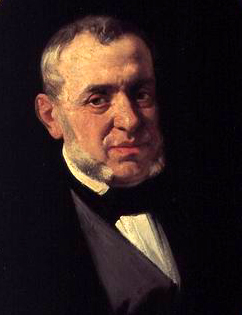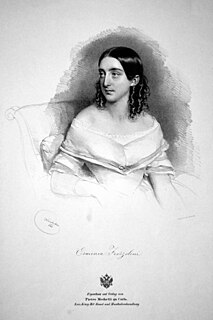The Festival della Valle d’Itria is a summer opera festival held in the south eastern Italian town of Martina Franca in the Apulia region. The Festival was founded in 1975 and performances are given in July and August each summer on a specially constructed stage in the outdoor courtyard of the Palazzo Ducale.

Adelaide di Borgogna, ossia Ottone, re d'Italia is a two-act opera composed by Gioachino Rossini to a libretto by Giovanni Schmidt. It was premièred at the Teatro Argentina in Rome on 27 December 1817.

Ivanhoé is an 1826 pastiche opera in three acts with music by Gioachino Rossini to a French-language libretto by Émile Deschamps and Gabriel-Gustave de Wailly, after Walter Scott's 1819 novel of the same name. The music was adapted, with the composer's permission, by the music-publisher Antonio Pacini from Rossini's operas, namely Semiramide, La Cenerentola, La gazza ladra, and Tancredi in order to introduce his music to Paris. An examination of the score shows that Pacini also used music from Bianca e Faliero, Armida, Maometto II, Aureliano in Palmira, Sigismondo, Torvaldo e Dorliska, Mosè in Egitto and an amount of newly composed music including fanfares and the gallop that was later to become famous from its inclusion in Guglielmo Tell. The work was premiered on 15 September 1826, at the Odéon Theatre.

Amica is an opera in two acts by Pietro Mascagni, originally composed to a libretto by Paul Bérel. The only opera by Mascagni with a French libretto, it was an immediate success with both the audience and the critics on its opening night at the Théâtre du Casino in Monte-Carlo on 16 March 1905. Mascagni himself conducted the performance. The opera had its Italian premiere on 13 May 1905 at the Teatro Costanzi in Rome.
Crispino e la comare o Il medico e la morte is an opera written collaboratively by Luigi Ricci and Federico Ricci with an Italian libretto by Francesco Maria Piave.

Il giuramento is an opera in three acts by Italian composer Saverio Mercadante. The libretto, by Gaetano Rossi, is based on Victor Hugo's 1835 play Angelo, Tyrant of Padua..

Orazi e Curiazi is an opera by the Italian composer Saverio Mercadante. It takes the form of a tragedia lirica in three acts. The libretto, by Salvadore Cammarano, is based on the Roman legend of the fight between Horatii and Curiatii. It was first performed at the Teatro San Carlo, Naples, on 10 November 1846.

Il re is a novella or opera in one act and three scenes by composer Umberto Giordano to an Italian libretto by Giovacchino Forzano. The opera premiered at La Scala in Milan on 12 January 1929.

Virginia is an opera, a tragedia lirica, in three acts by composer Saverio Mercadante. The Italian libretto by Salvadore Cammarano is based on Vittorio Alfieri's tragedy of the same name. Alfieri's play was in turn taken from a story in Livy's Ab Urbe condita. Although initially written for performance in 1850 at the Teatro di San Carlo in Naples, the subject matter of Mercadante's opera was objected to by the Bourbon government censors and performance was banned outright. That decision was widely ridiculed, not just in Italy, but throughout Europe. After the fall of the Kingdom of the Two Sicilies in 1861, the ban on the opera no longer existed.
Elisa Orlandi (1811–1834) was an Italian opera singer who was active at major opera houses in Italy from 1829 until her sudden death in 1834. Possessing a wide vocal range with a significant amount of coloratura facility, she tackled roles from both the mezzo-soprano and soprano repertoires. She is best remembered today for portraying the role of Giovanna Seymour in the world premiere of Gaetano Donizetti's Anna Bolena in 1830.

Antonio Cagnoni was an Italian composer. Primarily known for his twenty operas, his work is characterized by his use of leitmotifs and moderately dissonant harmonies. In addition to writing music for the stage, he composed a modest amount of sacred music, most notably a Requiem in 1888. He also contributed the third movement, Quid sum miser, to the Messa per Rossini, a collaborative work created by thirteen composers to honor Gioacchino Rossini.

Erminia Frezzolini was an Italian operatic soprano. She excelled in the coloratura soprano repertoire, drawing particular acclaim in the bel canto operas of Gaetano Donizetti and Vincenzo Bellini. She was married to tenor Antonio Poggi from 1841-1846.

Adelaide Borghi-Mamo was an Italian operatic mezzo-soprano who had an active international career from the 1840s through the 1880s. She was married to tenor Michele Mamo and their daughter, soprano Erminia Borghi-Mamo, also had a successful singing career.

Salvator Rosa is an opera seria in four acts composed by Antônio Carlos Gomes to a libretto in Italian by Antonio Ghislanzoni. It premiered at the Teatro Carlo Felice in Genoa on 21 March 1874. The plot is based on Eugène de Mirecourt's 1851 adventure novel, Masaniello, in turn loosely based on the lives of the Italian painter and poet, Salvator Rosa and Masaniello, a Neapolitan fisherman, who became leader of the 1647 revolt against the Spanish Habsburg rule in Naples.

Caritea, regina di Spagna, ossia La morte di Don Alfonso re di Portogallo, is an opera in two acts by Saverio Mercadante, with a libretto by Paolo Pola. It was premiered at Teatro La Fenice in Venice on 21 February 1826.

I due Figaro, o sia Il soggetto di una commedia is an opera in two acts by Saverio Mercadante to a libretto by Felice Romani based on Les deux Figaro by Honoré-Antoine Richaud Martelly. The opera was composed in 1826 but its production was delayed for some years due to censors' intervention.
Nitocri is an opera in two acts composed by Saverio Mercadante to libretto by Apostolo Zeno adapted by Lodovico Piossasco Feys. The libretto is a fictionalised account of the Egyptian queen Nitocris. The opera premiered at the Teatro Regio in Turin on 26 December 1824.

Nicola De Giosa was an Italian composer and conductor active in Naples. He composed numerous operas, the most successful of which, Don Checco and Napoli di carnevale, were in the Neapolitan opera buffa genre. His other works included sacred music and art songs. His songs were particularly popular, bringing him fame as a salon composer both in Italy and abroad. De Giosa died in Bari, the city of his birth, at the age of 66.

Francesca da Rimini is an 1831 opera by Saverio Mercadante to a libretto by Felice Romani based on Silvio Pellico's play which had already been set twice and ultimately was set by fifteen composers. It was to be premiered in Madrid in 1831, but the premiere was cancelled and the opera lost. It was rediscovered and performed in July 2016 at the Palazzo Ducale, Martina Franca for the Festival della Valle d'Itria, Italy.
Savino Monelli was an Italian tenor prominent in the opera houses of Italy from 1806 until 1830. Amongst the numerous roles he created in world premieres were Giannetto in Rossini's La gazza ladra, Enrico in Donizetti's L'ajo nell'imbarazzo and Nadir in Pacini's La schiava in Bagdad. He was born in Fermo where he initially studied music. After leaving the stage, he retired to Fermo and died there five years later at the age of 52.












